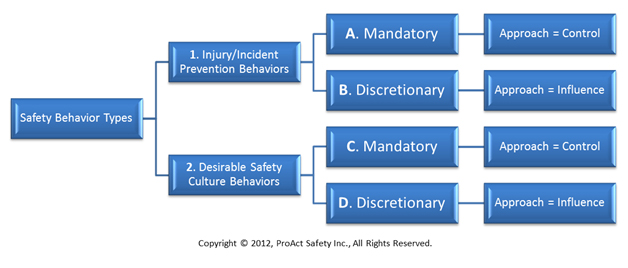Occupational Health & Safety - December 2012
By: Shawn M. Galloway
Printable Version
Dating back to prehistoric times, behaviors have always had a role in safety, and they always will. Behaviors were the primary, and sometimes only, tools for survival, remaining today as the last tool when all else fails. When in an environment you do not control, or when you lack the right tools or systems fail, it is up to the individual to behave in a manner for self-preservation. This is popularized with the common statement, "You are the one responsible for your safety." This is not ideal; it is, however, reality.
Most of the modern world now places a priority first on conditional safety, with government regulation focusing on leadership providing a safe working environment. Investment in conditional safety eventually reaches a point of diminished return, and when this occurs, these leaders turn to behaviors as another tool available in safety. How a leader views the role of behaviors, and what tools they determine to use will affect/influence the results recognized.
Controlling vs. Influencing Behavior
Some behaviors in safety must be controlled and are part of leadership responsibility to maintain compliance; some, however, can only be influenced. The tools to successfully manage control and influence should not overlap. Unfortunately, they occasionally do, creating much controversy, fear and resistance from organized labor.
Safety behaviors fall into two different and important categories: injury/incident prevention behaviors and desirable safety culture behaviors. Within each of these categories, there are two types of behaviors: mandatory and discretionary. (Figure 1). It is vital to acknowledge this and ensure the tools are focused appropriately.

Figure 1: The Four Types of Safety Behaviors
1.) Injury/Incident Prevention Behaviors
To prevent injuries there are (A.) mandatory injury/incident prevention behaviors expected of individuals. In mature safety systems these mandatory behaviors are covered by rules, policies, procedures, personal protective equipment, etc. Consistently enforcing these types of behaviors and controlling deviation are primarily the responsibility of leadership. Not doing so will result in disciplinary steps by many companies and government agencies. When individuals state, "Safety is a condition of employment," these are the behaviors they are referring to and should be controlled.
Further, there are injury/incident prevention behaviors that are (B.) discretionary in safety that generally go beyond what is considered compliance. Keeping your eyes focused on the direction of your travel and your body parts out of the path of potential moving energy are, for the most part, considered discretional. It would be difficult to enforce these behaviors as rules. Desires to focus on these types of behaviors created the many Behavior-Based Safety (BBS) approaches. BBS, most often an employee-led approach, can be a great, situationally-appropriate tool. It is a tool designed to only focus on one of the four types of behaviors in safety: discretionary injury/incident-prevention. Significant problems arise when BBS is directed at other behaviors, especially mandatory ones. BBS is a tool of influence, not another opportunity to control behavior mandatory to remain employed.
2.) Desirable Safety Culture Behaviors
All groups of individuals working together over an extended period of time create shared beliefs and eventually align behaviors specific to safety within their culture. Safety cultures are nothing new; they have always been a part of an organization. And, yes, you already have one, but is it the one you want providing differentiation and a competitive advantage in your company and industry?
When an organization determines the elements, characteristics and capabilities of their desirable safety culture, the remaining two types of safety behaviors become increasingly visible. Individuals helping to achieve the ideal culture will observe (C.) mandatory behaviors required of the safety culture (injury reporting, attend safety meetings, stopping the job for a safety concern, etc.) and (D.) discretionary cultural behaviors that exceed what is expected within the group (volunteer, identify improvement opportunities, mentor a new employee, etc.). The list of the cultural behaviors will differ for each group depending on maturity and the degree safety plays within organizational values and priorities.
Evolution
Those responsible for safety performance and culture must recognize a clear distinction in mandatory and discretionary behaviors, and the roles they play in injury/incident prevention and culture. Tools to control behavior should be used differently than tools used to influence. Certainly control is a type of influence, but what occurs when the controller is not around is the true test of its effectiveness.
There are behaviors we expect in injury/incident prevention and culture, which should be consistently enforced. However, every culture will mature and the desirable behaviors will evolve. How fast you go about evolving them is the difference in control and influence.

Shawn Galloway, CEO of ProAct Safety, is an expert in safety excellence. With almost thirty years of experience, he is a highly sought-after advisor, keynote speaker, and expert witness. Shawn has become a trusted partner to leading organizations across various industries worldwide. He ranks in the top 1% of the most prolific writers in his field, having authored over 500 articles and several bestselling books. He also launched the world's first safety podcast, Safety Culture Excellence©. As a recognized authority in safety, Shawn has received awards such as being named among the Top 50 People Who Most Influence EHS and a Top 10 Speaker, among others.
He is a regular guest on Bloomberg, Fox News, The Daily Mail, Dubai One, U.S. News & World Report, Sirius Business Radio, Wharton Business Daily, and leading safety magazines and podcasts. Shawn also serves as a member of the Harvard Business Review Advisory Council, Forbes Business Council, and Fast Company Executive Board, enabling his influence to shape safety thinking and strategy at the executive level.
